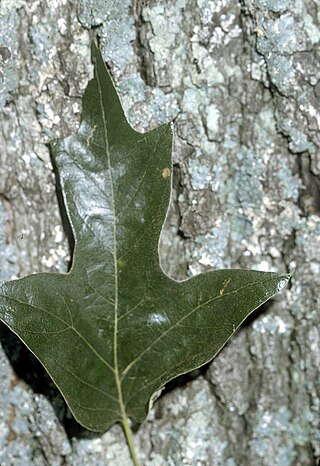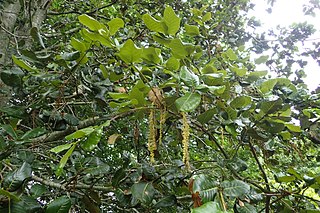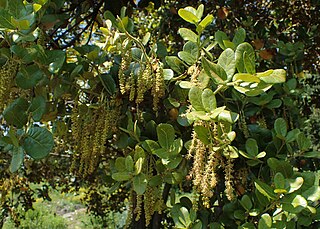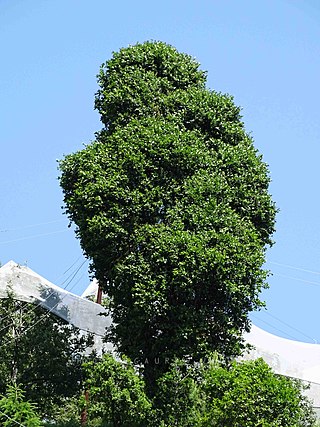
An oak is a hardwood tree or shrub in the genus Quercus of the beech family. They have spirally arranged leaves, often with lobed edges, and a nut called an acorn, borne in a cup. The genus is widely distributed in the Northern Hemisphere; it includes some 500 species, both deciduous and evergreen. Fossil oaks date back to the Middle Eocene. Molecular phylogeny shows that the genus is divided into Old World and New World clades, but many oak species hybridise freely, making the genus's history difficult to resolve.

Quercus ilex, the evergreen oak, holly oak or holm oak is a large evergreen oak native to the Mediterranean region. It is a member of the Ilex section of the genus, with acorns that mature in a single summer.

Quercus petraea, commonly known as the sessile oak, Cornish oak, Irish Oak or durmast oak, is a species of oak tree native to most of Europe and into Anatolia and Iran. The sessile oak is the national tree of Ireland, and an unofficial emblem in Wales and Cornwall.

Quercus falcata, also called southern red oak, spanish oak, bottomland red oak or three-lobed red oak is an oak. Native to the southeastern United States, it gets its name the "Spanish Oak" as these are the areas of early Spanish colonies, whilst "southern red oak" comes from both its range and leaf color during late summer and fall. The southern red oak is a deciduous angiosperm, so has leaves that die after each growing period and come back in the next period of growth.

Quercus dentata, also called Japanese emperor oak or daimyo oak is a species of oak native to East Asia. The name of the tree is often translated as "sweet oak" in English to distinguish it from Western varieties. It is placed in section Quercus.

Quercus faginea, the Portuguese oak, is a species of oak native to the western Mediterranean region in the Iberian Peninsula. Similar trees in the Atlas Mountains of northwest Africa are usually included in this species, or sometimes treated as a distinct species, Quercus tlemcenensis. It occurs in mountains from sea level to 1,900 metres above sea level, and flourishes in a variety of soils and climates. Out of all the oak forests in the Iberian Peninsula, the southern populations of Portuguese oak were found to have the highest diversity and endemism of spider species.

Quercus ithaburensis, the Mount Tabor oak, is a tree in the beech family Fagaceae. It is found from southeastern Italy to the Palestine region. It is the national tree of Jordan. Two subspecies are accepted, Quercus ithaburensis subsp. ithaburensis and Quercus ithaburensis subsp. macrolepis. Together with Quercus brantii, it forms a clade of distinct, closely related species within the oak section Cerris.

Quercus lanata, the woolly-leaved oak, is a species of Quercus native to southern and southeastern Asia, including India, Bhutan, Nepal, Indochina, and southwestern China. It is a large evergreen tree up to 30 metres tall. The leaves are thick and leathery, green on top but covered in thick wool on the underside. It is classified in subgenus Cerris, section Ilex.

Quercus pyrenaica, also known as Pyrenean oak, or Spanish oak is a tree native to southwestern Europe and northwestern North Africa. Despite its common name, it is rarely found in the Pyrenees Mountains and is more abundant in northern Portugal and north and northwestern Spain.

Quercus franchetii, commonly known as the zhui lian li evergreen oak, is a species of oak in the Ilex section of the genus, native to a wide area of eastern Asia. It is an oak native to China, northern Thailand and Vietnam, growing at altitudes between 800 and 2,600 metres.

Quercus baloot, the holm oak or holly oak is a rare species of oak that was described by Griffith in 1848. It is classified in subgenus Cerris and section Ilex. It is native to the Himalayas from 1,000–3,000 metres (3,300–9,800 ft).

Quercus phillyreoides is a species of flowering plant in the genus Quercus, placed in subgenus Cerris and section Ilex. It is evergreen, withstands frost and can be grown in hardiness zone 7. It is native to southern China, the Ryukyu Islands, and Japan, and has been introduced to Korea.

Quercus semecarpifolia is an Asian species of oak. It is native to the Himalayas and nearby mountains in Tibet, Afghanistan, India, Nepal, and Pakistan, where it is referred to as kharsu. It is classified in subgenus Cerris, section Ilex.

Quercus aquifolioides is a species of oak native to south-central China and Tibet. It is in the subgenus Cerris, section Ilex. It is a shrub or small tree adapted to high elevations.

Quercus floribunda, called the Moru oak or Mohru oak, Tilonj oak and green oak, is a species of oak native to Afghanistan, Pakistan, India's western Himalaya, and Nepal, typically found from 2,000 to 3,000 metres above sea level. It is in the subgenus Cerris, section Ilex. An evergreen tree with a dense crown reaching 30 m (98 ft), it is an important fuelwood and fodder species.
Quercus look, the look oak or Mount Hermon oak, is a species of oak in subgenus Cerris, section Cerris, native to the Levant region of Western Asia, including northern Israel, Lebanon, and Syria. Of the local oak species, it prefers to grow at the highest altitudes, for instance at c. 1800 m on Mount Hermon.
Quercus pannosa is a species of oak native to south-central China. An evergreen tree or shrub, it is found at very high elevations, flourishing at up to 4,270 metres above sea level. It is classified in subgenus Cerris, section Ilex.
Quercus guyavifolia is a species of flowering plant in the family Fagaceae, native to south-central China. An evergreen tree reaching 15 m (50 ft), its leaves are golden-brown on their undersides, making it one of the most attractive of the golden oaks. It is placed in section Ilex.
Quercus acrodonta is a species of flowering plant in the oak genus Quercus, family Fagaceae, native to central and southern China. It is typically found growing in valleys and on mountains 300 to 2,300 m above sea level. It is an evergreen tree, occasionally a shrub, reaching 15 m (50 ft), most of its structures are covered in a tomentose yellowish-gray layer. It is placed in section Ilex.

Quercus subgenus Cerris is one of the two subgenera into which the genus Quercus was divided in a 2017 classification. It contains about 140 species divided among three sections. It may be called the Old World clade or the mid-latitude clade; all species are native to Eurasia and North Africa.

















